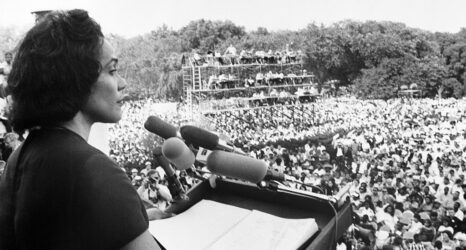Today, on the final day of Black Herstory Month, I honor my favorite Black woman of history: Ida B. Wells (1862-1931), married name Wells-Barnett, fierce, articulate, determined, courageous and completely uncompromising in her fight for racial and gender justice. And she did most of her fighting with a pen, as she was best known for writing anti-lynching newspaper articles.
Here’s how much of a fierce warrior Ms. Wells-Barnett was: when her parents (both former slaves) died when she was 16 during a yellow fever epidemic, Wells took responsibility for raising her five siblings. She lied about her age to get a job as a rural schoolteacher and went about on a demanding schedule of teaching, housework, childcare and attending college to receive a certification to teach in Memphis public schools.
Not long after, in 1884, she would set a “civil rights” example when, just months after the U.S. Supreme Court struck down the Civil Rights Act of 1875 but a decade before the “separate but equal” doctrine, Wells was evicted from the ladies’ coach of a train–but, of course, not without a fight! When she refused to move to the car in the back–reserved for “coloreds”–the conductor tried to manhandle her, but she bit the man’s hand. It took the help of four white passengers to drag her, kicking and screaming, out of the car. Afterwards, Wells sued the Chesapeake & Ohio Railroad Company–and won, but eventually lost on appeal.
At the Forefront of Anti-Racist Journalism
It was around this time that Ida B. Wells began her journalism career, writing for a Baptist newspaper, Living Way, and then the independent African American newspaper Free Speech, where she invested in one-third ownership of the paper. In 1891 she became a full-time writer after losing her teaching job for writing a scathing editorial about the local school board.
When her good friend Thomas Moss and his business partners, who ran a collective grocery business catering to the Black community, were lynched by an angry mob on March 9, 1892, Wells started investigating the many lynchings taking place in the South. Through meticulous research and sound journalism, she concluded that the stories spread about Black rapists on the prowl for white women were false and served as cruel cover-ups for white supremacy and Black disenfranchisement. Her inflammatory editorials put her life on the line, and she took to carrying a pistol underneath her petticoats, since, as she put it, she was determined to “sell my life as dearly as possible.” She further advocated that a “Winchester rifle should have a place of honor in every [Black] home.”
Wells was out of town on an East Coast tour when the Free Speech editorial was published that would banish her from the South forever. In it, she claimed that no one believed the “threadbare lies” white men were telling about the reasons for lynching and that those men need to be careful lest “a conclusion … be reached which will be very damaging to the moral reputation of their women” and their proclivity for landing in questionable situations with Black men. Her Free Speech office in Memphis was promptly ransacked and burned, and talk of lynching her escalated to a fever pitch; men stationed themselves at the local train station to await her return. She had to take her battle elsewhere, and she did. She toured Europe, where she spread her anti-lynching crusade in 1893, selling copies of her booklet Southern Horrors, which documented various cases of lynching, and helping create several British anti-lynching organizations. As England was the leading importer of Southern cotton, the British outcry put political and economic pressure on Southern politicians to take an anti-lynching stand. Lo and behold, lynchings started to decrease.
Ida B. Wells’ Intersectional Awareness
Wells had a keen ability to recognize not only the intersections of race, class and gender, but also how these issues factor in global contexts. Aside from her tour of Europe, she also joined with Frederick Douglass and other prominent men in the community to create a pamphlet protesting the World Columbian Exposition of 1893 (also known as the Chicago World’s Fair). One of these men included Ferdinand Lee Barnett, who would later become her husband.
In response to a fair that celebrated white supremacy, omitted African American achievements and cast Africans, Native Americans and other people of color as wild savages in various “human exhibits,” Wells and her educated cohort put together the pamphlet The Reason Why the Colored American is Not in the World’s Columbian Exposition, which included Wells’s essays on lynching, disenfranchisement and the convict leasing system.
Wells would marry in her 30s and have several children, but–except for a three-month stint at home after giving birth to her second child–she didn’t let marriage or motherhood interrupt her activism. She remained committed to fighting for woman’s suffrage and against lynching and racial discrimination. (One anecdote describes how she and a group of Black suffragettes attended the Suffrage Parade of 1913 in D.C., but racist white suffragists ordered that they march separately. Naturally, Wells refused and sneaked into the front of the parade when they least expected it!)
Ida B. Wells was a “pen warrior,” reminding us all of the power of an individual to agitate and mobilize against injustice–indeed, against evil. I often wonder, were Wells alive today, how she would use media to fight against the unjust criminal justice system and the prison industrial complex. How would she tie these issues to a Black feminist agenda? As an ardent journalist who would balk at the subtle ways Big Media gradually chips away at freedom of the press, what new ways would she approach her role as a “pen warrior”?
Let’s celebrate her spirit and her wisdom today, even as we draw inspiration from for her to forge our own paths and battles.
Further readings:
Paula Giddings, Ida B. Wells: A Sword Among Lions: Ida B. Wells and the Campaign against Lynching (Amistad Press, 2008).
Ida B. Wells’ autobiography Crusade for Justice (edited posthumously by her daughter and published in 1970 by the University of Chicago Press).
More From Ms.:





